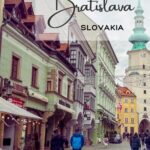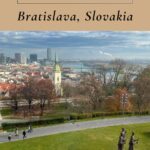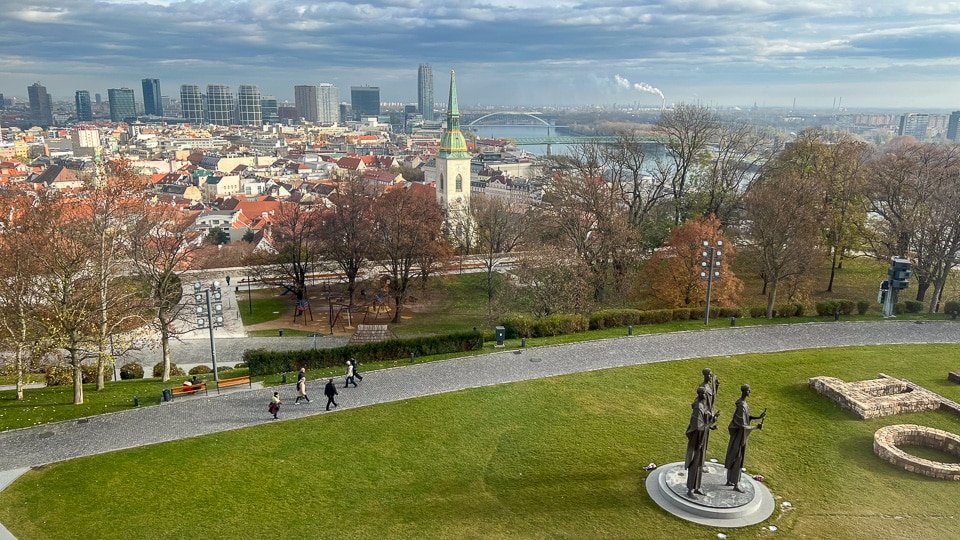
Bratislava, Slovakia, is easy to get to, easy to get around, and filled with interesting historic sights. Just an hour by train from Vienna, Austria, Slovakia's capital city might be just a day trip for some. We were glad to spend three days in Bratislava, soaking up history and bits of local culture, enjoying art old and new, and eating up highlights of the local cuisine. Our hotel played a big part in the Bratislava allure, too, so read on for specifics.
We arrived in Bratislava by train. Within a longer two-month tour of Europe we used a Eurail Global Pass for this part of our journey. The highlight our our train travel – even the main advantage of our Eurail pass – was visiting places like Bratislava and Graz, Austria, wonderful cities that afforded us all sorts of new and spontaneous opportunities. (We plan train travel as we go. Read all about using a Eurail Pass here.)
Table of Contents
History of Bratislava
Bratislava, the capital of Slovakia, lies just 50 miles (80 Km) east of Vienna. Whether you consider this Central Europe or Eastern Europe, you can get your bearings by thinking of all the bordering countries. The Slovak Republic borders Poland to the north, and, going counterclockwise, Czech Republic to the northwest, Austria to the west, Hungary to the south, and Ukraine to the east. In the 20th Century until 1989, it was part of what was called Czechoslovakia. The city’s population is 424,000.
To understand its importance, look into Bratislava's past. Prehistoric settlements dotted this area along the Danube River. The border of the Roman empire ran through here, and the area was part of the Great Moravian Empire after that. By the 11th Century, Bratislava was an important center of the Hungarian Empire, becoming the North Hungarian capital. Though the Mongolian invasions of the 1240s never overtook the city itself, they resulted in more fortifications. Trade routes by river and land further underscored Bratislava’s worldly role. Besides the castle, the city is home to the so-called Crown Cathedral (Cathedral of St. Martin). This was the coronation church of Hungarian kings and queens from 1563 to 1830.
Our visit overlapped with the annual “Struggle for Freedom and Democracy Day” holiday on November 17 that marks the independence of Slovakia in 1989, the end of the succession of Austro-Hungarian, Nazi, and Soviet rule.
Museums, Churches and Attractions in Bratislava
Other than the fact that museums and galleries were generally lacking in clear signage and flow, the content of museums we visited told rich stories about Bratislava’s history and its contemporary concerns. Specifically, most museums are part of the SNM – Slovak National Museum network – and are notable sources of national pride, evident in the museums' special exhibits and pointed didactics. What a great way to learn about a place.
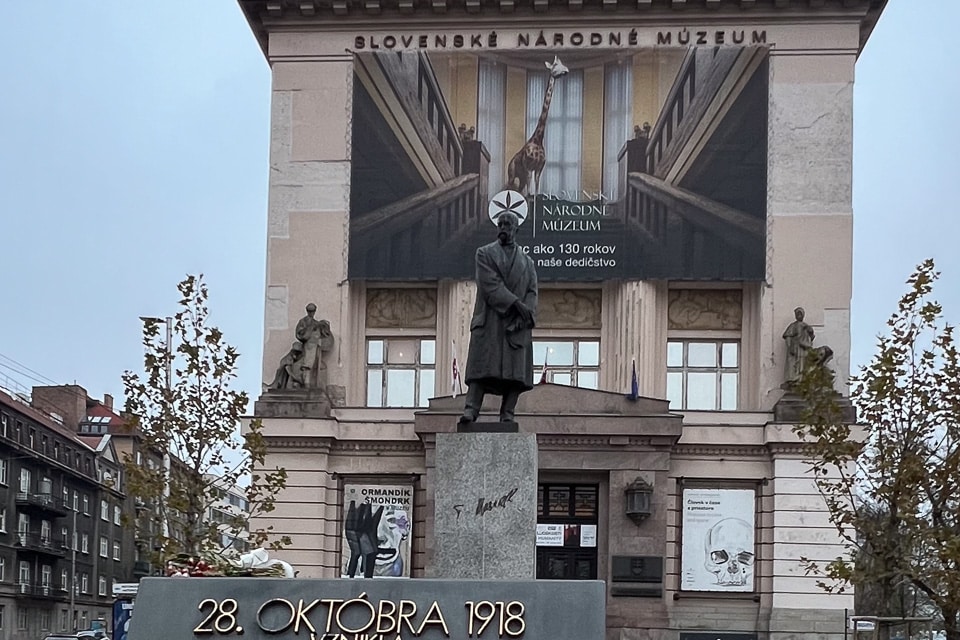
Bratislava Castle and History Museum
In this part of the world, castles are big, and this one is especially immense. It’s positioned atop castle hill on the banks of the Danube and affords views all the way to Austria on a clear day. It’s worth allowing time to walk up to the castle and around the grounds to enjoy the views over the city and across the river and the SNP (Slovak National Uprising) Bridge to the iconic UFO tower. Various huge courtyards in and around the castle are venues for concerts and events.
The castle, dating back to the 9th Century, has been rebuilt many times. The current, massive Renaissance version dates to the 16th Century and King Ferdinand. Inside (once we found the door and ticket desk) we found the red-carpeted broad staircase worthy of royalty and, as is our habit, we started at the top. We’re still not sure if we managed to find all the exhibits. Of top interest to us were exceptionally fine artifacts from the iron age and medieval times, as well as paintings, historic rooms, and information on Slovak history in the 20th Century.
Like its neighbors, this country found its citizens on both sides of World War II. An exhibit explaining the nation’s emblematic double cross and Slovak tricolor flag covers both the use and miss use of these symbols during ‘Normalization,’ the period from 1989 to present.
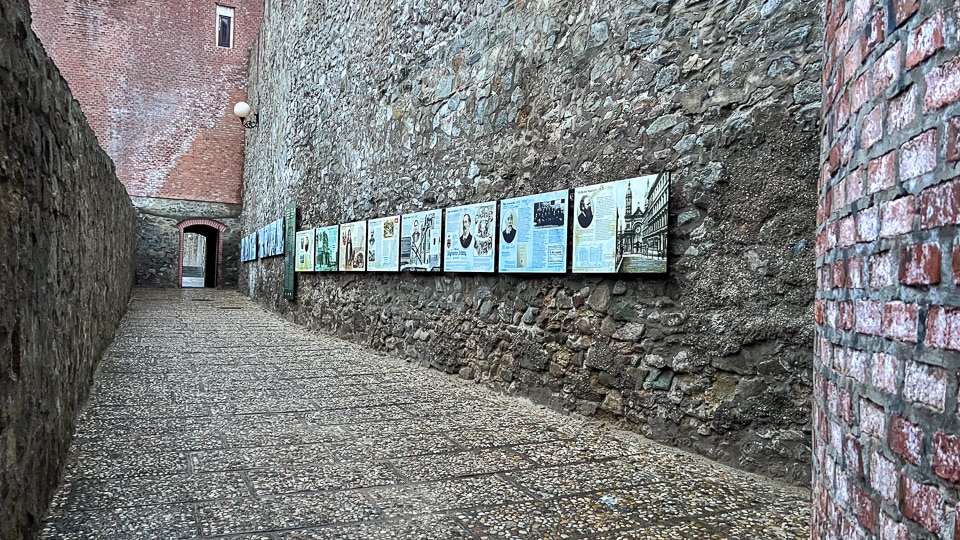
Museum of Jewish Culture
Don’t miss this small but powerful museum located just below the castle. Part of the Slovak National Museum network, the Jewish Museum highlights include handcrafted cultural items, documents, paintings and a special exhibit on Jozef “Joe” Veselsky. Veselsky was an athlete, table tennis champion, and advocate for non-discrimination and was known throughout the former Czechoslovakia and in Ireland, where he emigrated in 1949.
Unfortunately, much of Bratislava’s Jewish heritage landmarks have been destroyed, either by the effects of the holocaust and emigration or by the disinterest of the communist regime. The central Jewish neighborhood along Židovská, the “Jewish Street,” was essentially razed in order to build a wide street to the new bridge over the river. But along this way are dozens of plaques telling the stories of individuals and long-gone synagogue.
Look for these and several other Jewish heritage and memorial sites, including the door of the medieval synagogue.
Natural History Museum
The SNM Natural History Museum first grabs attention for its neo-classic architecture and its place along the river, facing a tree-lined park. We almost walked by, thinking that the great closed doors and lack of lights or signs meant it wasn’t open. ‘Try all the doors!’ is our motto for Bratislava.
This four-story museum packs in more than three million items in its collections from the natural world. Starting with the dramatic giraffe visible up the first flight of stairs, visitors are presented with mammals, birds, butterflies, bugs, fish, minerals, rocks, and all sorts of other species from around the world. Though displays may be a bit cluttered for modern sensibilities, the sheer depth of the exhibits makes this a top natural history museum of Europe.
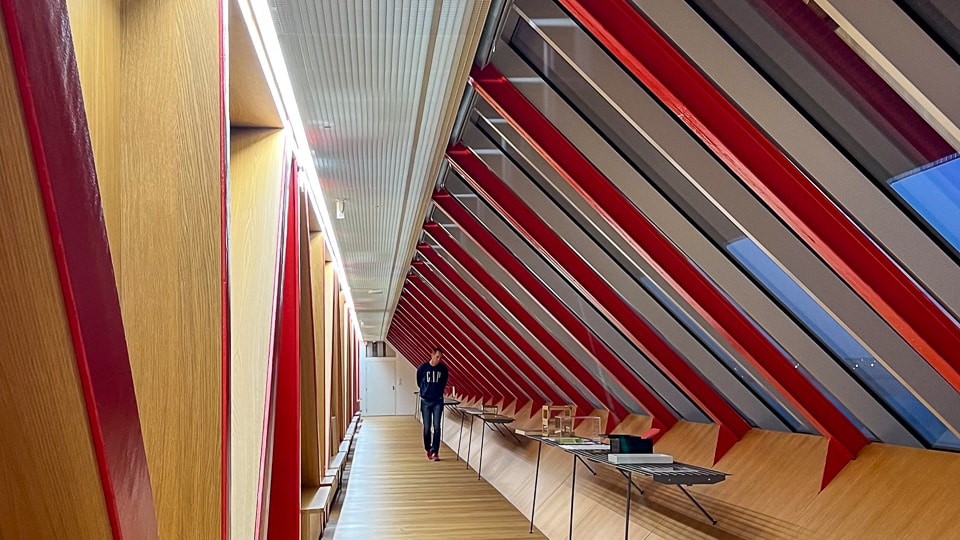
Slovak National Gallery
The Slovak National Gallery is marked by the modern (2022) addition to an 18th Century building set on the banks of the Danube. The expansion architecture plays a big part in the experience, creating and breaking a fourth wall, if you will. Our visit coincided with a hands-on architecture exhibit. At any time, though, a visitor will want to pause frequently in the new wing to take in the lines and the views.
The museum possesses tens of thousands of artworks and is regularly exhibiting a dizzying array of collections. The emphasis seems to be on modern and contemporary work (or deconstruction of same, as we witnessed in a special exhibit), but also includes some Old Masters, applied arts, design, and photography.
St. Martin's Cathedral
This 3-nave Gothic church from the 15th century was the coronation church of the Hungarian kings, and still displays a huge replica of the Hungarian crown atop its tower. St. Martin's Cathedral is noted in the “Road of Emperors and Kings” itinerary, see below. Notably, both Beethoven and Liszt performed their work here.
Central European House of Photography
Because our visit was over a holiday weekend, we weren’t able to visit the House of Photography. But photography is featured annually in November, and we were able to see a few window displays of the event’s participating artists. In this region, photography is given its just place in the art world. We're fond of the Robert Capa Contemporary Photography Center in Budapest, Hungary, as another example.
Tourist Office Walking Tour/ Bratislava Card
Though we’re not sure if the Bratislava Card made economic sense for us on our short visit, our visit to the Bratislava Tourist Office was worthwhile. We arranged a walking tour which introduced us to Eva and to many hidden corners and obscure history, right in the center of Bratislava's old town.
We toured the main square, the old town hall, viewing churches and civic buildings, old neighborhoods, and getting a sense of both power and everyday life over the centuries. Highlights included a visit to the 120-year-old Pharmacy Salvatore, commentary on street art and local characters, and background information on the Church and royalty since the Middle Ages. Besides the “Coronation Church” of St. Martin's, the Art Nouveau-style Blue Church (Church of St. Elizabeth) is one of the most visited landmarks in the city.
Considering the historic performances in Bratislava by Franz Listz and Ludwig Beethoven reminded us of the Slovak capital's importance as a cultural center through the years. Mozart played in Bratislava, then called Pressburg, as a young child, and Haydn served as music director at the palace of the Esterházy family. A short walk around the old town of Bratislava will include Hviezdoslav Square with the Slovak National Theatre.
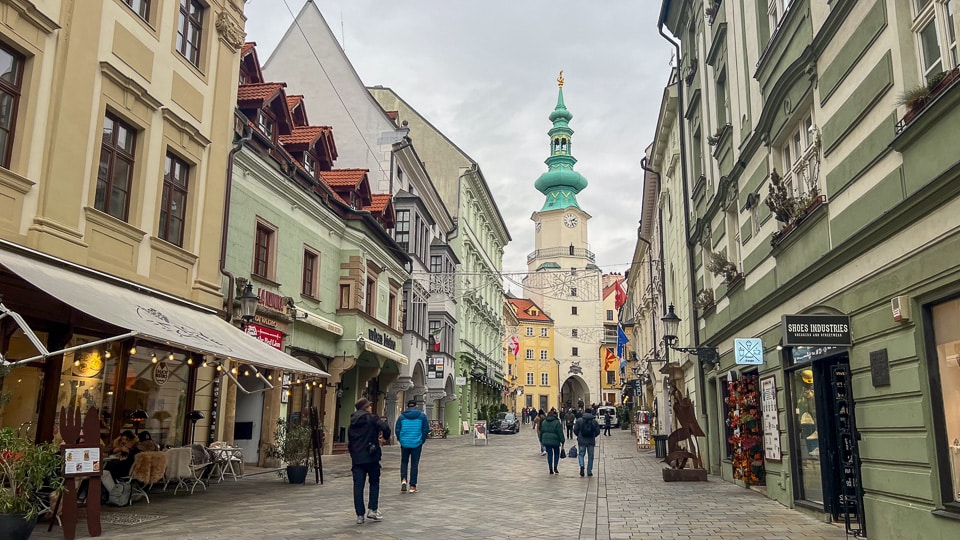
More to See in Bratislava
Michael's Tower is a landmark of the old city, with its onion-shaped, copped-covered roof. Michael's Gate is the only one of the original walled-town gates remaining. When we were there, we spotted a black flag flying from the top. That, we were told, was a silent protest for the so-called “Minister of the Unculture,” the extremely unpopular Minister of Culture. It turns out she’s widely regarded as unqualified and self-serving. (You can read a related story here.)
The campaigns and protests and fake news brought us, of course, to a conversation about U.S. politics. We were reminded of the far-flung impact of our political quagmire, and that many people abroad are more in tune to the situation than our fellow U.S citizens, it seems.
For another vantage point, walk across the SNP Bridge, a.k.a. the UFO Bridge or New Bridge, built 1969-1972. Check out the UFO-shaped restaurant and observation deck on the top of the bridge structure. This bridge, by the way, has the distinction of being the longest single pylon bridge in the world, but we haven't fact-checked that.
Restaurants: Where to Eat in Bratislava
Traditional food includes schnitzel , goulash, potatoes and vegetables, crepes and hot lemon or orange drinks, served with or without alcohol. Many restaurants have elevated the traditional cuisine to high standards, and choices also include coffee cafes and beer brewpubs.
Gatto Matto Venturska. Though this little eatery had no room for us when we showed up, we indicated we were willing to wait outside. Quickly, we were offered a chair inside and a glass of wine, then minutes later were seated at a table. We discovered an excellent white wine here, where a pizza menu is offered alongside the other main course options. This family-run business was top notch and friendly.
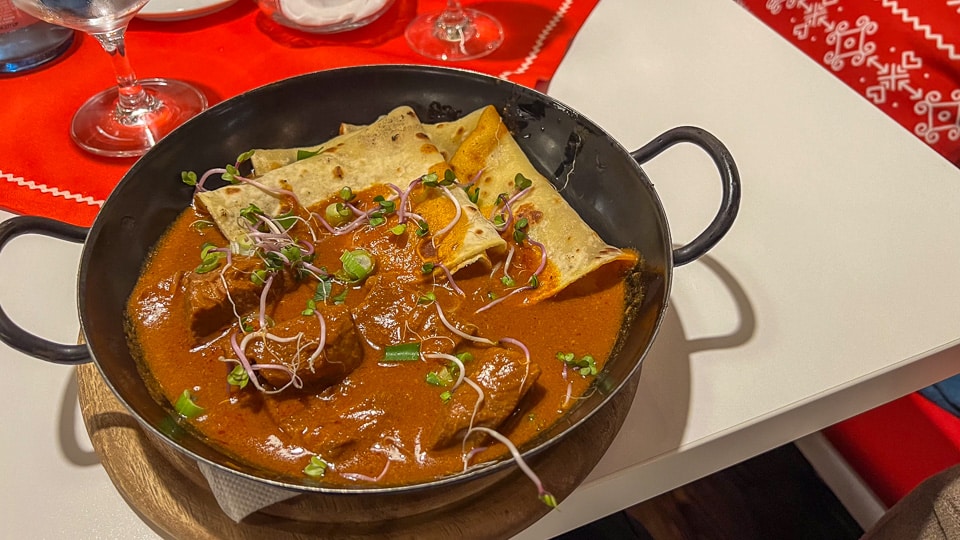
Koliba Kamzik Zelená. Recommended by our city walk guide, this restaurant attached to a boutique hotel serves traditional fare prepared in a bright, appealing space. It is definitely a place for locals, not just the guests of the hotel. Potatoes are in abundance on the menu, even in the dessert section.
Zylinder Café Restaurant. The feel of this place hearkens back to the early 20th Century, an unassuming open room with a few booths by the window and the rest filled with wooden tables and chairs. This is your place for Wiener Schnitzel.
Fach. For more innovative fare. Recommended by various people we asked, but we didn’t fit in a visit.
The UFO restaurant. Another place we didn’t eat at, but is on most lists because of the views. Bratislava Card holders get a 10% discount.
The Mirror Bar. Don't miss this dark room with potted palms and a menu of extraordinary drinks named after famous people who've passed through Bratislava.
Hotels: Where to Stay in Bratislava
Radisson Blu Bratislava Carlton. At once elegant and intriguing, this hotel by Radisson was a 5-star luxury hotel in its heyday. Now designated four stars, the Carlton exudes history and dominates the Hviezdoslav Square, also anchored by the opera house and lined with restaurants. The location is right between the river and the city centre. Maybe because a basement casino can be accessed from the hotel on one end of the block, or because our breakfast table looked across the street to the America Embassy, the whole experience felt like the setting of a good spy novel. In fact, the rooms are lovely and large, the service excellent, the breakfasts in the Savoy Restaurant dining room are nice enough to linger over. Recommended.
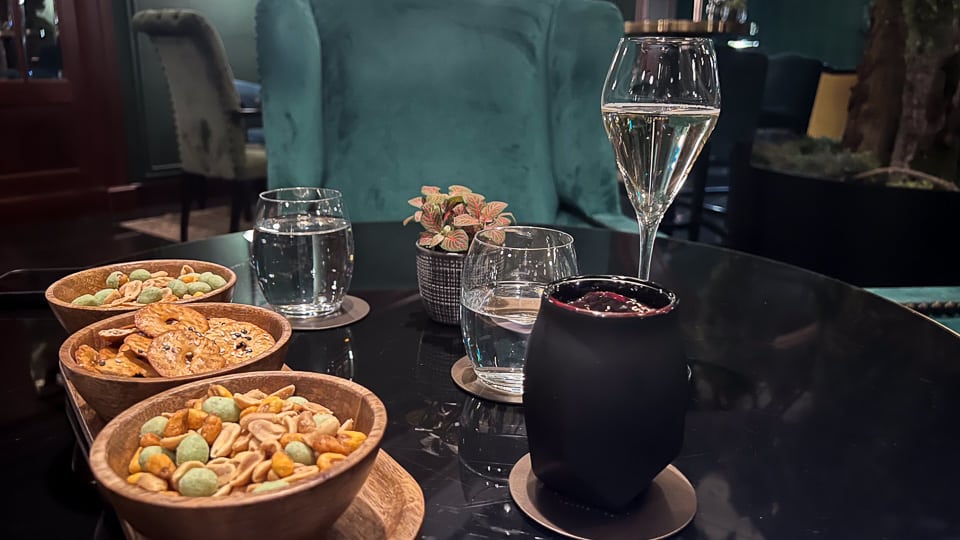
Day Trips from Bratislava
If you have the time (and lets hope you are not visiting Bratislava on a day trip from Vienna) do check out some recommended itineraries in the region.
Little Carpathians Wine Route
Road of Emperors and Kings. From Regensburg to Budapest, this route along the Danube covers four countries, three capitals, and 14 World Heritage Sites.
Up Your Travel Skills
Looking to book your next trip? Use these resources that are tried and tested by us. First, to get our best travel tips, sign up for our email newsletter. Then, be sure to start your reading with our Resources Page where we highlight all the great travel companies and products that we trust. Travel Accessories: Check out our list of all the accessories we carry to make getting there and being there a lot easier. Credit Cards: See our detailed post on how to choose the right travel rewards credit card for you. Flights: Start finding the very best flight deals by subscribing to Thrifty Traveler. Book your Hotel: Find the best prices on hotels with Booking.com. See all of the gear and books we like in one place on our Amazon shop.Got a comment on this post? Join the conversation on Facebook, Instagram, or Threads and share your thoughts!

